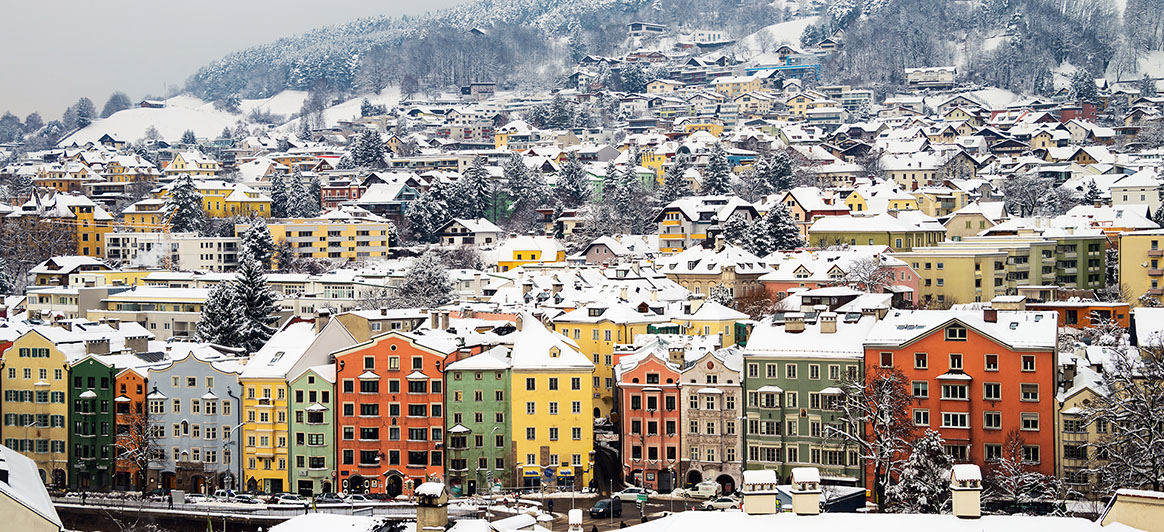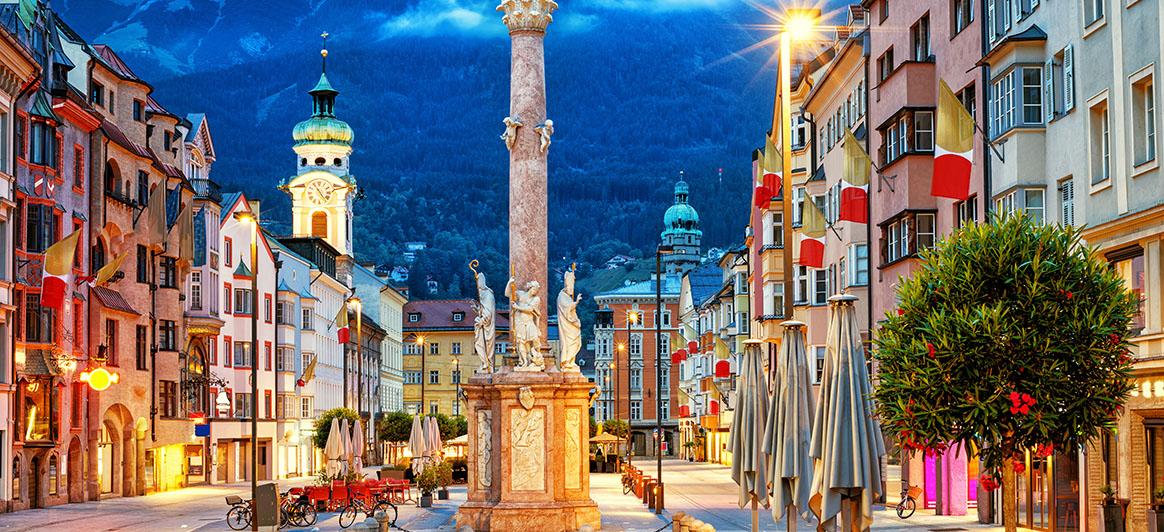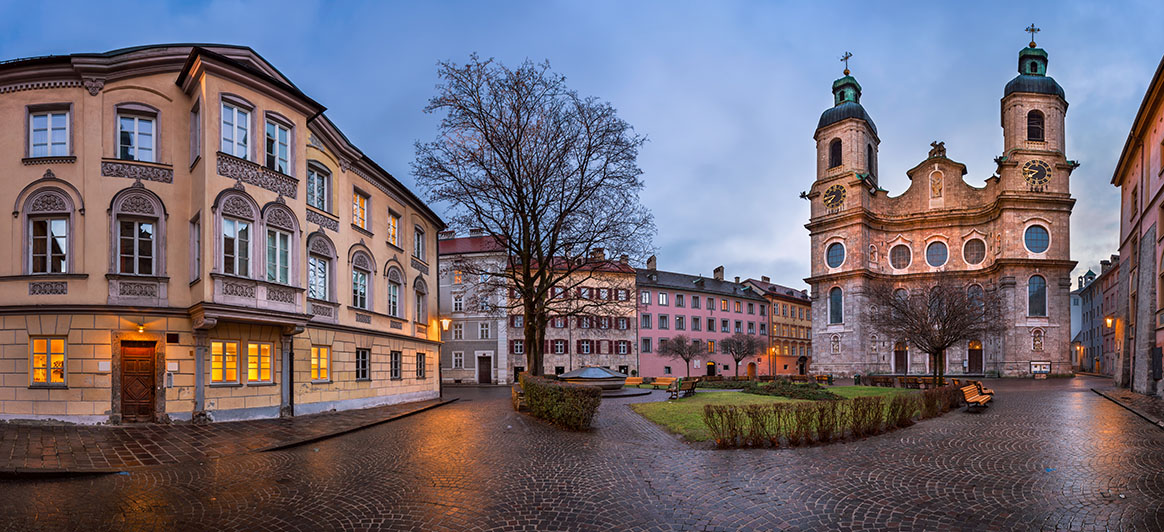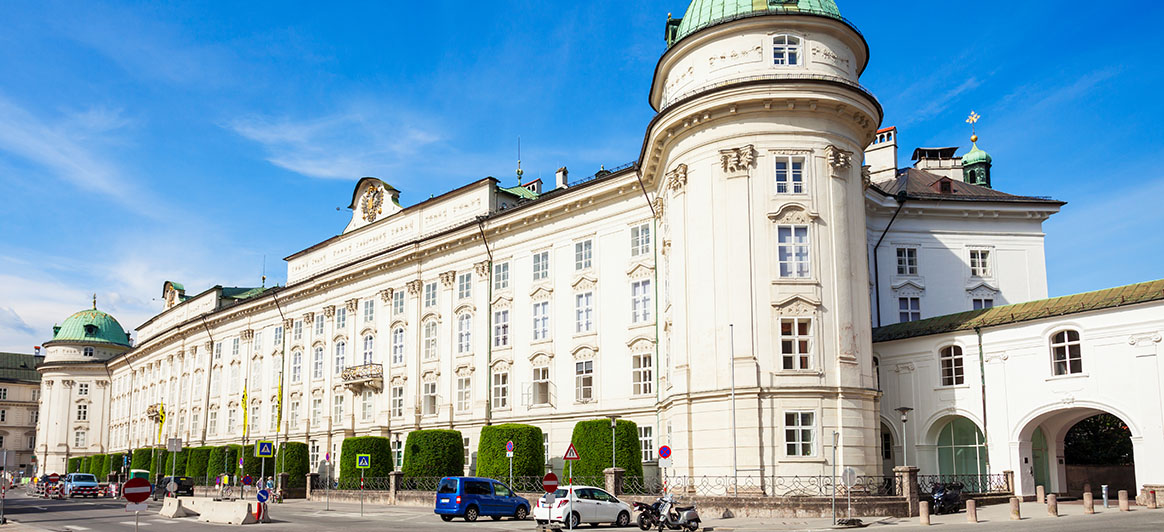
Book a Flight to Innsbruck
expand_more
1 Passenger, Economy
expand_morePromotional Code
expand_moreexpand_more
today
today
To book tickets for children traveling alone click here
Find the lowest fares to Innsbruck
flight_takeoff
flight_land
€
There are no fares that match your filter criteria. Please adjust your filters.
There are no fares that match your filter criteria. Please adjust your filters.*Fares displayed have been collected within the last 48hrs and may no longer be available at time of booking. Additional fees and charges for optional products and services may apply.
AEGEAN popular flights to Innsbruck
flight_takeoff
flight_land
€
Cabin Class option undefined Selectedkeyboard_arrow_down
Select Travel Class
There are no fares that match your filter criteria. Please adjust your filters.
There are no fares that match your filter criteria. Please adjust your filters.*Fares displayed have been collected within the last 48hrs and may no longer be available at time of booking. Additional fees and charges for optional products and services may apply.

Plan your Trip to Innsbruck
Colorful, youthful and postcard-perfect, the capital of the Austrian state of Tyrol is one of Europe's most beautiful cities, an architectural gem nestled in a majestic valley of the Austrian Alps. To the avid winter sports enthusiasts it is known as the modern "Mecca of alpine skiing" and one of the most popular winter resorts in the world, with top infrastructure and unparalleled ski culture.
With a glorious history that goes back to the Romans and up to Napoleon and the House of Habsburg, the small settlement of 12th Century on the south bank of the river Inn became one of the most important commercial centers of medieval Europe and enjoyed great glory as the imperial city of the Habsburgs. The cosmopolitan air of the old empire and the sui generis Tyrolean traditions coexist and ideally complement the current urban setting of a modern city with a rich cultural life, excellent gastronomy and vibrant nightlife.
Stroll the cobbled streets of the medieval Old Town with its colorful Tyrolean houses and shopping arcades with specialist artisan shops.Admire the magnificent town houses of Herzog-Friedrich-Strasse with their baroque and rococo facades such as the iconic Helbling House or climb the 133 steps of the Stadtturm for a panoramic view of Innsbruck. Cross the aristocratic Maria-Theresien-Strasse (the commercial heart of the New Town) with its dazzling 17th-18th centuries mansions, countless outdoor cafés and historical monuments such as the St. Anne's Column (1703) and the Triumphal Arch (1756).
Surrounded by the snow-capped peaks of the northern Alps, the hospitable host of the 1964 and 1976 Winter Olympics is an ideal destination for outdoor enthusiasts year round. Hop on the impressive Nordkettenbahnen (Innsbruck's state-of-the-art cable car, designed by Zaha Hadid) that connects the city center to the Hungerburg, Seebrube (1,905m) and Hafelekar (2,330m) peaks in just 20 minutes and explore Tyrol's alpine nature. Fly with Aegean to Innsbruck and come and enjoy a unique experience of rejuvenation, adventure, history and culture in the picturesque "Alpine Capital" in the shadows of the majestic Nordkette mountain range.
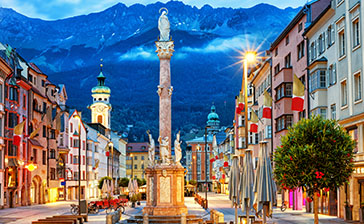
Golden Roof (Goldenes Dachl)
Built by Emperor Maximilian I (between 1457 - 1500), this covered balcony overlooking the main square of the city is the most emblematic symbol of Innsbruck. Its roof is made of 2,657 gilded copper shingles, while the rich fresco decoration and 18 reliefs depicting a series of scenes from the Emperor's life are considered unique works of late Gothic and early Renaissance sculpture. The balcony served as Maximilian's box, from which he would address his subjects or watch artistic performances in the square. The original reliefs were replaced with faithful copies in 1952 for their protection. Six of them have been restored and are on display in the small interactive museum inside the building, dedicated to the life and reign of Maximilian.
Address: Herzog-Friedrich-Straße 15, 6020 Innsbruck, https://www.innsbruck.gv.at/goldenesdachl
Imperial Palace (Kaiserliche Hofburg)
Although completed in 1500 by Emperor Maximilian I, the imperial residence of Tyrol was given its present imposing form by Maria Theresa in the 18th century. The building was rebuilt in the Viennese Baroque style and was designed by the best painters of the time. Don't miss the dazzling "Hall of Giants" (Riesensaal) with its ceiling fresco by court painter Franz Anton Maulbertsch. The fresco depicts portraits of Maria Theresa's children, including those who did not make it to adulthood, represented as infants in grey wigs above the clouds.
Address: Rennweg 1, 6020 Innsbruck, https://www.burghauptmannschaft.at/Betriebe/Hofburg-Innsbruck/Museum.html
St. James Cathedral (Dom Zu St. Jacob)
Since 1180, Innsbruck Cathedral has towered over the rooftops of the city and was an important Christian pilgrimage site in the Middle Ages (a stop on the "Way of St James"). Following its restoration in the 18th century (1714-1724), the monument acquired even greater glory thanks to its Baroque interior, decorated with great works of art. Admire the masterpiece "Mary of Succor" (Maria Hilf) above the altar, the work of the German painter Lukas Cranach the Elder. Equally impressive are the frescoes depicting scenes from the life of Saint James, and the plasterwork is by the brothers Cosmas Damian Asam and Egid Quirin Asam respectively.
Address: Domplatz 6, 6020 Innsbruck, https://www.dibk.at/Media/Pfarren/Innsbruck-St.-Jakob-Dompfarre-Propstei
Ski Jump Tower (Bergisel Ski Jump)
Designed in 2002 by renowned architect Zaha Hadid, the elegant ski jump tower rises 250 meters above Innsbruck on the wooded historic hill of Bergisel. From a distance, the structure gives the illusion of a steel sculpture. At the top of the tower is a café - restaurant and terrace with a 360° panoramic view of the city, the 28,000-seat Olympic stadium and the surrounding mountain peaks. The site can be easily reached by cable car from the city center in just 2 minutes.
Address: Bergiselweg 3, 6020 Innsbruck,https://www.bergisel.info/at/
Alpine Zoo (Alpenzoo)
Europe's highest zoo (750 meters above sea level) was created in 1962 and today is home to 150 endemic species of Alpine fauna. These include ibex (a species of wild goat), brown bears, wolves, marmots, vultures and other creatures of the alpine ecosystem. The complex is just 1.5 km from the city center and is an ideal getaway for young and old alike. The complex includes an aquarium, a terrarium, a farm with native Tyrolean animals, a playground and accessible fencing for direct contact with the animals. You can take the Hungerburgbahn (the cable car to Hungerburg) or walk up the hill from the end of the Rennweg.
Address: Weiherburggasse 37, 6020 Innsbruck, https://www.alpenzoo.at/de/
Folk Art Museum (Tiroler Volkskunstmuseum)
Housed in the magnificent New Abbey (next to the Church of the Court), this wonderful anthropological museum offers a three-century journey (16th-18th centuries) into the everyday life of Tyrolean peasants, clergy and nobles through rare objects. The wonderful collection includes farm equipment, children's toys, household items, traditional costumes, church and folk art. Don't miss the faithful reproductions of Tyrolean house interiors and the collection of baby cradles from the 18th century to the 1970s.
Address: Universitätsstraße 2 , 6020 Innsbruck, https://www.tiroler-landesmuseen.at/haeuser/tiroler-volkskunstmuseum/
Ambras Castle (Schloss Ambras)
This 16th-century medieval fortress in the hills above Innsbruck was transformed by Archduke Ferdinand II, who bought it in 1564, into a famous Renaissance castle - a symbol of the Habsburg dynasty - and with its architectural structures, magnificent gardens and art collections, the historic building is still very grand today. Be sure to visit the impressive Spanish Hall (Spanische Saal), a 30-meter-long hall with a carved wooden ceiling and 27 frescoes depicting life-size portraits of Tyrolean nobility. The Lower Castle is home to the 15th-century Armour Collection (Rustkammer) and the Collection of Art and Curiosities (Kunst und Wunderkammer). In the Upper Castle you can trace the family tree of the Habsburgs in the Portrait Gallery with 300 portraits of nobles (15th - 19th centuries).
Address: Schloßstraße 20, 6020 Innsbruck, https://www.schlossambras-innsbruck.at/
Swarovski Museum (Swarovski Crystal World)
The glittering world of the legendary Tyrolean crystal house comes to life in all its splendor in this stunning theme park-museum in the village of Wattens (just 20 km from Innsbruck). The entrance to the building is "guarded" by the figure of a giant face surrounded by nature and a 4-story play area for families with children. Inside, visitors can explore 18 themed "Wonder Rooms", including the "Silent Light" (a frozen room with snow all year round), the "Crystal Theatre" (with surreal scenes of objects, puppets and 3D light shows) and the "Giant's Room" (with personal items such as a cane, gloves, ring and accordion). Don't miss the world's largest crystal, a 300,000-carat piece weighing 62 kilograms. The main hall is dominated by a crystal dome with 590 facets and thousands of hand-crafted crystals, the creation of artistic director André Heller. At the exit you will find an art shop with a wide range of souvenirs and jewelry, as well as the café-restaurant "Daniels Kristallwelten".
Address: Kristallweltenstraße 1, 6112 Wattens, https://kristallwelten.swarovski.com/
Tyrol Panorama Museum with Kaiserjager museum
In this modern interactive museum (2011), the "Myth of Tyrol", an exhibition dedicated to the turbulent history of Tyrol and the Tyroleans' monumental struggle for freedom, unfolds in an imaginative way. The centerpiece of the museum is the gigantic 'Riesenrundgemälde' (1896), one of the last panoramic (360 degree) paintings of the 19th century, covering an area of 1,000 square meters and depicting the historic battle of Bergisel between Napoleon's Bavarians and the Tyroleans of Austria-Hungary. It is also home to the "Imperial Infantry Museum", a historical collection of Tyrolian military history from the 18th to the 20th centuries.
Address: Bergisel 1-2, 6020 Innsbruck, https://www.tiroler-landesmuseen.at/haeuser/tirol-panorama-mit-kjm/
Court Church (Hofkirche)
Right next to the palace, the Court Church draws visitors to the stunning Mausoleum of Emperor Maximilian, an imposing marble structure covered with 24 Renaissance reliefs depicting scenes from his life. The cenotaph (Maximilian is buried in Wiener Neustadt, outside Vienna, as the church was not completed until 100 years after his death) is guarded by 28 giant bronze statues of his biological and spiritual ancestors (such as King Arthur of England), sculpted by great artists such as Albrecht Dürer. Don't miss the "Silver Chapel" (Silberne Kapelle) with its silver relief of the Virgin Mary, the 20 statues of the patron saints of the House of Habsburg and the tomb of Tyrolean national hero, Andreas Hofer.
Address: Universitätsstraße 2, Innsbruck.
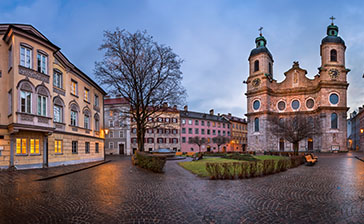
The colorful medieval buildings of the Old Town house countless elegant boutiques under their arcades, while in the cobbled streets of the historic center offer unique little shops selling Tyrolean souvenirs and fine handicrafts by local artists. The Tyrol region has a long tradition of craftsmanship. Look for high quality glassware with original decorations, embroidered fabrics, wrought iron objects, wood carvings, grotesque masks, hats and leather goods. Also, traditional Tyrolean clothing such as lederhosen (for men) and dirndls (for women) or loden cloth (the classic woolen coat of the Alps).
The commercial heart of the city beats on the main pedestrian street of Maria-Theresien-Strasse, where shopping is combined with stops at outdoor cafés, restaurants and Gluhwein cafés. It is also home to Innsbruck's famous shopping centers, such as the stylish Rathausgalerien (2002) or the neighboring Kaufhaus Tyrol, which owes its elegant design to renowned architect David Chipperfield. Both offer exclusive brands from the world of fashion, accessories, sporting goods, luxury cosmetics, home design and food.
The busy Herzog-Friedrich-Strasse is home to the famous Swarovski flagstore, while Museumstrasse (near the Central Railway Station) offers the latest in mountain fashion with all the luxury brands in clothing, ski and mountaineering equipment and après-ski looks. In Innsbruck you can even design and order your own ski mask. On the same street you will find the modern and renovated Sillpark (since 1990), another popular shopping center with all the international fashion chains and a farmer's market on the ground floor, where you can buy countless local delicacies directly from the producers.
If you have time, it's worth exploring the markets of St. Nicholas and Wilten, two up-and-coming shopping areas outside the city center.
For gastronomy lovers, the Market Hall by the river hides countless Alpine culinary treasures. Meet local producers from the region and buy fine local products such as Schnnaps, brandies and fruit spirits (apple, pear, plum) from the depths of the Tyrolean forests, liqueurs, smoked sausages and smoked fish, golden alpine honey, mustard and pickles, local cheese Graukäse (a hallmark of Tyrolean gastronomy) and excellent Speck.
Saturday's bazaar in Franziskanerplatz offers a unique thrill for bargain hunters of second-hand home furnishings, clothing, artwork and antiques.
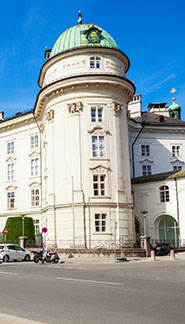
From traditional taverns serving home-style cooking and alpine huts with small conservatories perched at dizzying heights to award-winning gourmet restaurants in large hotels and resorts with a cosmopolitan atmospheres, Innsbruck's culinary scene offers a wide range of dining experiences. Depending on your mood, you can sample authentic Tyrolean cuisine, classic imperial specialties from the Habsburg era, international cuisine (from Asian to Mexican flavors) and the favorite (for Tyroleans and non-Tyroleans alike) Italian cuisine. The options are endless. Pick up a basket of Tyrolean delicacies and enjoy a picnic in the fresh Alpine air - by the lush waters of the River Inn, in the imperial gardens or on a plateau on the Nordkette at 2,000 meters above sea level. Reserve a table for breakfast in a gondola on the cable car to Patscherkofel. Enjoy cycling tours or hiking with tasting stops at producers' farms and Tyrolean farmhouses.
Try authentic Tyrolean recipes such as Tiroler Knödel (bacon dumplings), Tiroler Gerstlsuppe (barley soup), Gebackene Schinkenfleckerl (soufflé with dumplings and ham), Schlutzkrapfen (spinach and cheese ravioli), Tiroler Rindersaftbraten (beef slices with parmesan), Tiroler Saftgulasch (goulash with diced bacon served with polenta), Tiroler Kirchtagskrapfen (pancakes stuffed with dried pears, prunes and poppy seeds), Bauerngröstl (mixture of pork, bacon, potatoes and eggs), speck, beef broth soup and strips of pancakes.
Alternatively, you can sample the classic imperial cuisine with Viennese soup, wienerschnitzel, fried chicken and Tyrolean gröstl with potatoes and meat, tafelspitz (boiled beef). In the Old Town, you'll find excellent Viennese cafés with an old-world atmosphere for food or just desserts such as the classic sachertorte (dark chocolate cake with whipped cream, served since 1832), apple strudel and the Italian-style buckwheat cake with chopped hazelnuts and grated apple.
Whatever you choose, don't leave Innsbruck without trying the locals' favorite, Kaspressknödel. These are crispy dumplings with a fluffy filling of the famous Tyrolean grey cheese Graukäse. They are usually eaten in a hot beef soup, but you can also serve them with a salad or sauerkraut.
At Christmas, the capital of the Alps offers visitors an extra temptation with the culinary tradition of Kiachl (a type of doughnut that comes in two versions: savory with sauerkraut and sweet with cranberries and powdered sugar). Stop at a Kiachlstand and buy one up for the road. During the carnival season, the Faschingskrapfen (doughnuts filled with apricot jam and powdered sugar) are a favorite.
Innsbruck's nightlife is vibrant and intense, with something for everyone. The night scene can include Tyrolean nights with percussion bands, Tyrolean singing (yodeling or zither) and traditional dancing in a beer hall or tavern, live music and drinking in relaxed pubs (Beisel) with a party atmosphere, lounging in stylish bars with aperitifs and fine drinks from expert mixologists and patrons who enjoy modern luxury. Most of the haunts are located in the pedestrian zone of Maria-Theresien-Strasse and in the side streets of the Old Town. Those with inexhaustible après-ski stamina, can follow the local youth to the dance floors of the all-night clubs under the arches of the aqueduct to party until dawn.
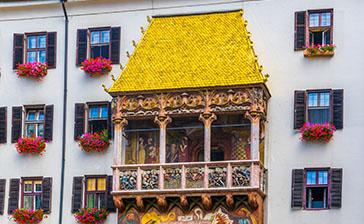
Early Music Festival (Festwochen der Alten Musik)
Innsbruck honors its past (the city was a magnet for great composers of the 16th and 17th centuries) with an iconic festival of Baroque and Renaissance music. Every summer (since 1976), the capital of Tyrol welcomes top musicians, orchestras, ensembles and international performers with a program ranging from baroque operas to church music recitals and open-air lunchtime concerts. Events are hosted in some of the finest cultural venues, such as Schloss Ambras, the Hofkirche, the Hofburg lawns and the Landestheater.
New Orleans Festival
From Innsbruck to the American South and from the River Inn to the Mississippi, with music as a bridge, this annual festival is the ultimate summer event for jazz and blues music lovers. Three nights of electrifying live performances bringing together the best of New Orleans and Louisiana with artists from Innsbruck. Get ready for a musical feast of New Orleans jazz, rhythm 'n' blues, soul and zydeco.
Gans Anders Festival
A three-day festival of dance, music and art held every September on the shores of Baggersee Lake in Innsbruck. Thousands of alternative culture lovers, live bands and DJs gather around the three stages to enjoy the sounds of electronic and acoustic music of all genres, from techno to jazz. The festival also hosts artists' workshops that encourage experimentation and free creativity.
ARTfair Innsbruck
The ultimate rendezvous for contemporary art lovers, collectors and gallerists takes place every October. More than 90 exhibitors from 10 countries present unique masterpieces from the 19th to the 21st century, from painting and photography to glass and porcelain.
Four Hills Tournament:
For 72 years, the spectacular Bergisel Olympic Ski Jump (designed by architect Zaha Hadid in 2001) has hosted one of the world's most iconic and famous ski jumping competitions. The third race in a row (of a total of 4, held on an equal number of hills in Austria and Germany) offers sports fans an unforgettable spectacle with the participation of the world's best aerialists and a panoramic view of Innsbruck. (1-2 January 2024).
LUMAGICA Innsbruck
For Christmas travelers young and old, Innsbruck is a fairytale experience. One of them invites visitors and residents to the imperial gardens for a "journey back in time" through the magic of light. The one kilometer circular walk is marked by imaginative lighting installations (many of them interactive) that combine art with state-of-the-art technology in a unique way.

Transport from the airport
Innsbruck Kranebitten Airport (INN) is located 4 km west of the city center of Innsbruck.The local bus line F (Flughafen- NEU-Rum Kaplanstrasse) connects the airport with the city center of Innsbruck and stops at the main railway station (Innsbruck Hauptbahnhof) on Maria-Theresien-Strasse. The line runs daily between 05:47 and 23:05, with a frequency of every 15 - 30 minutes (weekdays) and every 20 - 30 minutes (Saturdays, Sundays and public holidays). The journey from the airport to Innsbruck Central Station takes 20 minutes, with 11 stops. The ticket costs €2.30 and can be bought from vending machines, online or from the driver (at a higher price).
For faster travel, take a taxi. The taxi pick-up and drop-off point is located in front of the airport's passenger terminal. The journey to the city center takes 5-10 minutes and the average fare is EUR 10 - 15. If you want to plan your trip to/from the airport, the official airport website suggests a list of 15 private transport companies for direct booking ( https://www.innsbruck-airport.com/en/passengers-visitors/to-from-the-airport-parking/taxi-and-transfer/ ).

Grand Place: Baroque buildings with gilded facades, such as the 15th century City Hall, form the backdrop to the mediaeval square, frequented in the past by such eminent figures as Victor Hugo, Karl Marx and Jean Cocteau.
Royal Museums of Fine Arts: More than 10,000 works of art from the 15th to the 21th century. Of particular note is the collection of Flemish painters, especially the Rubens gallery with a number of masterpieces by the Baroque artist.
Address: Rue de la Régence 3, 0032 2 508 32 11, www.fine-arts-museum.be
Magritte Museum: An iconic neoclassical building in the Grand Place, with two hundred works by the sui generis Belgian painter René Magritte, one of the leading surrealist artists of the 20th century.
Address: Rue de la Régence 3, 003225083211, www.musee-magritte-museum.be
Musical Instrument Museum: A popular attraction for music-lovers, this restored art nouveau building houses an amazing collection of 7,000 musical instruments from all over the world, both traditional and contemporary. The café on the top floor offers amazing views of the city.
Address: Rue Montagne de la Cour 2, 003225450130, www.mim.be/museum
Belgian Comic Strip Centre: The museum is housed in a superb art nouveau building designed by the architect Victor Horta, and is a sight worth seeing in its own right. This is the ideal place to meet the famous reporter with the distinctive hairstyle, Tintin, and his faithful dog Milou, creations of the Belgian cartoonist Hergé, as well as the Smurfs, Lucky Luke and many other comic book heroes who have enlivened the childhoods of whole generations. On the top floor there is a Museum of the Imagination, where you can follow the evolution of comics from paper to 3D animation. Or you can just chill out in the library and leaf through some of the 30,000 comics in its collection.
Address: Rue des Sables 20, 003222191980, www.comicscenter.net/en/home
Atomium: This is Brussels’ most futuristic landmark, although in fact it is now more than half a century old, having been constructed for the International Exhibition of 1958. The grandiose architectural sculpture rising above the heart of the city represents an iron atom magnified 156 billion times! You can go inside, walk among the spheres and tubes, and enjoy the 3600 view of the city.
Address: Avenue de l'Atomium, 1020 Ville de Bruxelles, 0032 2 475 47 75, http://atomium.be
Mini-Europe: This is a wonderful attraction for visitors of all ages. Located close to the Atomium, Mini-Europe is a park containing the most famous buildings, monuments and natural landscapes in Europe re-created on a Lilliputian scale. With just one stride you can travel from the Eiffel Tower and the gondolas of Venice to the Coliseum in Rome and the eruption of Vesuvius at Pompeii.
Address: Bruparck 1020 Brussels, 003224741313, www.minieurope.com
Parlamentarium: If you want to find out more about the workings of the European Parliament, and how the decisions are taken which affect the lives of everyone living in Europe, you should visit the fascinating European Parliament Visitors’ Centre. Through interactive exhibits and activities, available in all 24 official languages of the EU, visitors of all ages can explore the importance of European integration.
Address: Willy Brandt Building Rue Wiertz 60, 003222832222, www.europarl.europa.eu/visiting/el/visits/parlamentarium.html
Royal Belgian Institute of Natural Sciences: Tarantulas, termites, dinosaur skeletons, a piece of moon rock – just a few of the 37 million items in the collection of the Institute. The exhibits allow visitors to travel back in time to the Neanderthal era, to visit the north and south poles, or to meet Tyrannosaurus Rex and his friends in the largest collection of dinosaur skeletons in Europe. The wildlife exhibits are truly breath-taking – you won’t be able to tear yourselves away!
Address: Rue Vautier 29, 003226274380, www.naturalsciences.be
Manneken-Pis: Near the Grand Place you will find a little street called Rue de l’Etuve, home to the famous Manneken-Pis, a bronze 17th century statue of a little boy urinating – the city’s most frequently photographed landmark!

The colorful medieval buildings of the Old Town house countless elegant boutiques under their arcades, while in the cobbled streets of the historic center offer unique little shops selling Tyrolean souvenirs and fine handicrafts by local artists. The Tyrol region has a long tradition of craftsmanship. Look for high quality glassware with original decorations, embroidered fabrics, wrought iron objects, wood carvings, grotesque masks, hats and leather goods. Also, traditional Tyrolean clothing such as lederhosen (for men) and dirndls (for women) or loden cloth (the classic woolen coat of the Alps).
The commercial heart of the city beats on the main pedestrian street of Maria-Theresien-Strasse, where shopping is combined with stops at outdoor cafés, restaurants and Gluhwein cafés. It is also home to Innsbruck's famous shopping centers, such as the stylish Rathausgalerien (2002) or the neighboring Kaufhaus Tyrol, which owes its elegant design to renowned architect David Chipperfield. Both offer exclusive brands from the world of fashion, accessories, sporting goods, luxury cosmetics, home design and food.
The busy Herzog-Friedrich-Strasse is home to the famous Swarovski flagstore, while Museumstrasse (near the Central Railway Station) offers the latest in mountain fashion with all the luxury brands in clothing, ski and mountaineering equipment and après-ski looks. In Innsbruck you can even design and order your own ski mask. On the same street you will find the modern and renovated Sillpark (since 1990), another popular shopping center with all the international fashion chains and a farmer's market on the ground floor, where you can buy countless local delicacies directly from the producers.
If you have time, it's worth exploring the markets of St. Nicholas and Wilten, two up-and-coming shopping areas outside the city center.
For gastronomy lovers, the Market Hall by the river hides countless Alpine culinary treasures. Meet local producers from the region and buy fine local products such as Schnnaps, brandies and fruit spirits (apple, pear, plum) from the depths of the Tyrolean forests, liqueurs, smoked sausages and smoked fish, golden alpine honey, mustard and pickles, local cheese Graukäse (a hallmark of Tyrolean gastronomy) and excellent Speck.
Saturday's bazaar in Franziskanerplatz offers a unique thrill for bargain hunters of second-hand home furnishings, clothing, artwork and antiques.

From traditional taverns serving home-style cooking and alpine huts with small conservatories perched at dizzying heights to award-winning gourmet restaurants in large hotels and resorts with a cosmopolitan atmospheres, Innsbruck's culinary scene offers a wide range of dining experiences. Depending on your mood, you can sample authentic Tyrolean cuisine, classic imperial specialties from the Habsburg era, international cuisine (from Asian to Mexican flavors) and the favorite (for Tyroleans and non-Tyroleans alike) Italian cuisine. The options are endless. Pick up a basket of Tyrolean delicacies and enjoy a picnic in the fresh Alpine air - by the lush waters of the River Inn, in the imperial gardens or on a plateau on the Nordkette at 2,000 meters above sea level. Reserve a table for breakfast in a gondola on the cable car to Patscherkofel. Enjoy cycling tours or hiking with tasting stops at producers' farms and Tyrolean farmhouses.
Try authentic Tyrolean recipes such as Tiroler Knödel (bacon dumplings), Tiroler Gerstlsuppe (barley soup), Gebackene Schinkenfleckerl (soufflé with dumplings and ham), Schlutzkrapfen (spinach and cheese ravioli), Tiroler Rindersaftbraten (beef slices with parmesan), Tiroler Saftgulasch (goulash with diced bacon served with polenta), Tiroler Kirchtagskrapfen (pancakes stuffed with dried pears, prunes and poppy seeds), Bauerngröstl (mixture of pork, bacon, potatoes and eggs), speck, beef broth soup and strips of pancakes.
Alternatively, you can sample the classic imperial cuisine with Viennese soup, wienerschnitzel, fried chicken and Tyrolean gröstl with potatoes and meat, tafelspitz (boiled beef). In the Old Town, you'll find excellent Viennese cafés with an old-world atmosphere for food or just desserts such as the classic sachertorte (dark chocolate cake with whipped cream, served since 1832), apple strudel and the Italian-style buckwheat cake with chopped hazelnuts and grated apple.
Whatever you choose, don't leave Innsbruck without trying the locals' favorite, Kaspressknödel. These are crispy dumplings with a fluffy filling of the famous Tyrolean grey cheese Graukäse. They are usually eaten in a hot beef soup, but you can also serve them with a salad or sauerkraut.
At Christmas, the capital of the Alps offers visitors an extra temptation with the culinary tradition of Kiachl (a type of doughnut that comes in two versions: savory with sauerkraut and sweet with cranberries and powdered sugar). Stop at a Kiachlstand and buy one up for the road. During the carnival season, the Faschingskrapfen (doughnuts filled with apricot jam and powdered sugar) are a favorite.
Innsbruck's nightlife is vibrant and intense, with something for everyone. The night scene can include Tyrolean nights with percussion bands, Tyrolean singing (yodeling or zither) and traditional dancing in a beer hall or tavern, live music and drinking in relaxed pubs (Beisel) with a party atmosphere, lounging in stylish bars with aperitifs and fine drinks from expert mixologists and patrons who enjoy modern luxury. Most of the haunts are located in the pedestrian zone of Maria-Theresien-Strasse and in the side streets of the Old Town. Those with inexhaustible après-ski stamina, can follow the local youth to the dance floors of the all-night clubs under the arches of the aqueduct to party until dawn.

Early Music Festival (Festwochen der Alten Musik)
Innsbruck honors its past (the city was a magnet for great composers of the 16th and 17th centuries) with an iconic festival of Baroque and Renaissance music. Every summer (since 1976), the capital of Tyrol welcomes top musicians, orchestras, ensembles and international performers with a program ranging from baroque operas to church music recitals and open-air lunchtime concerts. Events are hosted in some of the finest cultural venues, such as Schloss Ambras, the Hofkirche, the Hofburg lawns and the Landestheater.
New Orleans Festival
From Innsbruck to the American South and from the River Inn to the Mississippi, with music as a bridge, this annual festival is the ultimate summer event for jazz and blues music lovers. Three nights of electrifying live performances bringing together the best of New Orleans and Louisiana with artists from Innsbruck. Get ready for a musical feast of New Orleans jazz, rhythm 'n' blues, soul and zydeco.
Gans Anders Festival
A three-day festival of dance, music and art held every September on the shores of Baggersee Lake in Innsbruck. Thousands of alternative culture lovers, live bands and DJs gather around the three stages to enjoy the sounds of electronic and acoustic music of all genres, from techno to jazz. The festival also hosts artists' workshops that encourage experimentation and free creativity.
ARTfair Innsbruck
The ultimate rendezvous for contemporary art lovers, collectors and gallerists takes place every October. More than 90 exhibitors from 10 countries present unique masterpieces from the 19th to the 21st century, from painting and photography to glass and porcelain.
Four Hills Tournament:
For 72 years, the spectacular Bergisel Olympic Ski Jump (designed by architect Zaha Hadid in 2001) has hosted one of the world's most iconic and famous ski jumping competitions. The third race in a row (of a total of 4, held on an equal number of hills in Austria and Germany) offers sports fans an unforgettable spectacle with the participation of the world's best aerialists and a panoramic view of Innsbruck. (1-2 January 2024).
LUMAGICA Innsbruck
For Christmas travelers young and old, Innsbruck is a fairytale experience. One of them invites visitors and residents to the imperial gardens for a "journey back in time" through the magic of light. The one kilometer circular walk is marked by imaginative lighting installations (many of them interactive) that combine art with state-of-the-art technology in a unique way.

Transport from the airport
Innsbruck Kranebitten Airport (INN) is located 4 km west of the city center of Innsbruck.The local bus line F (Flughafen- NEU-Rum Kaplanstrasse) connects the airport with the city center of Innsbruck and stops at the main railway station (Innsbruck Hauptbahnhof) on Maria-Theresien-Strasse. The line runs daily between 05:47 and 23:05, with a frequency of every 15 - 30 minutes (weekdays) and every 20 - 30 minutes (Saturdays, Sundays and public holidays). The journey from the airport to Innsbruck Central Station takes 20 minutes, with 11 stops. The ticket costs €2.30 and can be bought from vending machines, online or from the driver (at a higher price).
For faster travel, take a taxi. The taxi pick-up and drop-off point is located in front of the airport's passenger terminal. The journey to the city center takes 5-10 minutes and the average fare is EUR 10 - 15. If you want to plan your trip to/from the airport, the official airport website suggests a list of 15 private transport companies for direct booking ( https://www.innsbruck-airport.com/en/passengers-visitors/to-from-the-airport-parking/taxi-and-transfer/ ).

